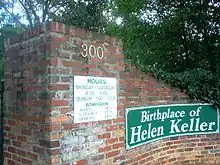Ivy Green
Ivy Green is a historic house museum at 300 West North Commons in Tuscumbia, Alabama, United States. Built in 1820, it was the birthplace and childhood home of Helen Keller (1880–1968), the famous deaf-blind author and speaker. A National Historic Landmark honoring Keller's life, it is now a museum open to the public.
Ivy Green (Helen Keller Birthplace*) | |
 Ivy Green in 2009 | |
  | |
| Location | 300 West North Commons, Tuscumbia, Alabama, United States |
|---|---|
| Coordinates | 34°44′22″N 87°42′24″W |
| Area | 10 acres (4.0 ha) |
| Built | 1820 |
| Architect | David Keller; Mary Fairfax Moore |
| NRHP reference No. | 70000101 |
| Significant dates | |
| Added to NRHP | August 25, 1970[1] |
| Designated NHL | March 31, 1992[2] |
Description and history
Ivy Green is located in a residential area north of downtown Tuscumbia, on the north side of West North Commons at Keller Lane. The property's principal features are the main house, the birthplace cottage, and the well. The main house is a 1-1/2 story frame structure with a gabled roof and clapboarded exterior. It has a five-bay facade, with sash windows around a roughly centered entrance. The entrance is sheltered by a gabled portico, and is framed by sidelight and transom windows. Nearby stands the birthplace cottage, a modest structure originally built as a plantation office, that was refurbished as a bridal suite for Arthur Henley Keller's second wife, who bore him Helen Keller in 1880. In between the two buildings stand the well and pump that played a key role in Helen Keller's development.[3]
The main house at Ivy Green was built in 1820 by David Keller, Helen Keller's grandfather.[4] The well pump is where Helen Keller first achieved a communicated breakthrough with her teacher and companion, Anne Sullivan.[3]
The property became a museum dedicated to Helen Keller in 1954. A fire in 1972 caused minor damage and resulted in the donation of additional materials by the Keller family.[3]


The Miracle Worker
Every summer, for over 30 years, the Helen Keller Foundation has presented outdoor performances of William Gibson's The Miracle Worker. The play is usually performed from early June through mid-July. It is especially popular during the Helen Keller Festival held in Tuscumbia every June.
References
- "National Register Information System". National Register of Historic Places. National Park Service. January 23, 2007.
- "Ivy Green (Helen Keller Birthplace)". National Historic Landmark summary listing. National Park Service. Archived from the original on 2009-03-01. Retrieved 2007-10-28.
- Page Putnam Miller (June 7, 1991). "National Register of Historic Places Registration: Ivy Green / Keller, Helen, Birthplace" (pdf). National Park Service. Cite journal requires
|journal=(help) and Accompanying 4 photos (2 exterior, 1 of water pump, and 1 of Helen Keller and Anne Sullivan) from 1990 and undated. (515 KB) - "The Life of Helen Keller, National Institute of Blind People". Archived from the original on 2007-06-07. Retrieved 2007-06-08.
External links
- Official website
- Historic American Buildings Survey (HABS) No. AL-317, "Helen Keller House, 300 West North Commons, Tuscumbia, Colbert County, AL", 8 photos, 4 data pages
